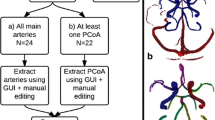Abstract
The accuracy of 2D phase contrast (PC) magnetic resonance angiography (MRA) depends on the alignment between the vessels and the imaging plane. PC MRA imaging of blood flow is challenging when the flow in several vessels is to be evaluated with one acquisition. For this purpose, semi-automatic determination of the plane most perpendicular to several vessels is proposed based on centerlines extracted from 3D MRA. Arterial centerlines are extracted from 3D MRA based on iterative estimation-prediction, multi-scale analysis of image moments, and a second-order shape model. The optimal plane is determined by minimizing misalignment between its normal vector and the centerlines’ tangent vectors. The method was evaluated on a phantom and on 35 patients, by seeking the optimal plane for cerebral blood flow quantification simultaneously in internal carotids and vertebral arteries. In the phantom, difference of orientation and of height between known and calculated planes was 1.2° and 2.5 mm, respectively. In the patients, all but one centerline were correctly extracted and the misalignment of the plane was within 12° per artery. Semi-automatic centerline extraction simplifies and automates determination of the plane orthogonal to one vessel, thereby permitting automatic simultaneous minimization of the misalignment with several vessels in PC MRA.
Similar content being viewed by others
References
Detre JA et al (1999) Noninvasive magnetic resonance imaging evaluation of cerebral blood flow with acetazolamide challenge in patients with cerebrovascular stenosis. J Magn Reson Imaging 10:870–875
Keston P, Murray AD, Jackson A (2003) Cerebral perfusion imaging using contrast-enhanced MRI. Clin Radiol 58:505–513
Hermier M et al (2003) The delayed perfusion sign at MRI: a potential marker of collateral leptomeningeal blood flow in acute stroke?. Neuroradiology 30:172–179
Watanabe Z et al (2001) The Usefulness of 3D MR angiography in surgery for ruptured cerebral aneurysms. Surg Neurol 55:359–364
Marchand B et al (2002) Standardized MR protocol for the evaluation of MRA sequences and/or contrast agents effects in high-degree arterial stenosis analysis. MAGMA 14:259–267
Spilt A et al (2002) Reproducibility of total cerebral blood flow measurements using phase contrast magnetic resonance imaging. J Magn Reson Imaging 16:1–5
Zhao M, Charbel FT, Alperin N, Loth F, Clark ME (2000) Improved phase-contrast flow quantification by three-dimensional vessel localization. Magn Reson Imaging 18:697–706
Tizon X (2004) Algorithms for the analysis of 3D magnetic resonance angiography images. Acta Universitatis Agriculturae Sueciae, Uppsala, Sweden (ISBN 91-576-670-4)
Wink O (2004) Vessel axis determination. Print Partner Ipskamp, Amsterdam, The Netherlands (ISBN 90-393-3698-9)
Wink O, Frangi AF, Verdonck B, Viergever MA, Niessen WJ (2002) 3D MRA coronary axis determination using a minimum cost path approach. Magn Reson Med 47:1169–1175
Kanitsar A et al (2001) Computed tomography angiography: a case study of peripheral vessel investigation. In: IEEE visualization, Piscataway, pp 477–480
Avants BB, Williams JP (2000) An adaptive minimal path generation technique for vessel tracking in CTA/CE-MRA volume images. In: Delp SL, DiGioia AM, Jaramaz B (eds) MICCAI. Springer, Berlin Heidelberg New York, pp 707–716
van Bemmel CM, Spreeuwers LJ, Viergever MA, Niessen WJ (2003) Level-set-based artery-vein separation in blood pool agent CE-MR angiograms. IEEE Trans Med Imaging 22(10):1224–1234
Deschamps T, Cohen LD (2001) Fast extraction of minimal paths in 3D images and applications to virtual endoscopy. Med Image Anal 5:281–299
Young S, Pekar V, Weese J (2001). Vessel segmentation for visualization of MRA with blood pool contrast agent. In: Niessen WJ, Viergever MA (eds) MICCAI. Springer, Berlin Heidelberg New York, pp 491–498
Lorigo L et al (2001) CURVES: Curve evolution for vessel segmentation. Med Image Anal 5(3):195–206
Sato Y et al (1998) Three-dimensional multi-scale line filter for segmentation and visualization of curvilinear structures in medical images. Med Image Anal 2(2):143–168
Frangi AF, Niessen WJ, Hoogeveen RM, van Walsum T, Viergever MA (1999) Model-based quantitation of 3D magnetic resonance angiographic images. IEEE Trans Med Imaging 18(10):946–956
Gratama van Andel HAF, Meijering E, van den Lugt A, Stokking R (2004) VAMPIRE: improved method for automated center lumen line definition in atherosclerotic carotid arteries in CTA data. In: Barillot C, Haynor DR, Hellier P (eds) MICCAI. Springer, Berlin Heidelberg New York, pp 525–532
Azencot J, Orkisz M (2003) Deterministic and stochastic state model of right generalized cylinder (RGC-sm): application in computer phantoms synthesis. Graph Models 65:323–350
Aylward SR, Bullitt E (2002) Initialization, noise, singularities and scale in height ridge traversal for tubular object centerline extraction. IEEE Trans Med Imaging 21(2):61–75
Boldak C, Rolland Y, Toumoulin C, Coatrieux JL (2003) An improved model-based vessel tracking algorithm with application to computed tomography angiography. J Biocybern Biomed Eng 3(1):41–64
Toumoulin C, Boldak C, Dillenseger J-L, Coatrieux J-L, Rolland Y (2001) Fast detection and characterization of vessels in very large data sets using geometrical moments. IEEE Trans Biomed Eng 48(5):604–606
Kass M, Witkin A, Terzopoulos D (1987) Snakes: active contour models. Int J Comput Vis 1(4):321–331
Sato Y et al (2000) Tissue classification based on 3D local intensity structures for volume rendering. IEEE Trans Vis Comput Graph 6(2):160–180
Catmull E, Rom R (1974) A class of local interpolating splines. In: Computer aided geometric design. Academic, New York, pp 317– 336
Hernández-Hoyos M et al (2002) Computer assisted analysis of three-dimensional MR angiograms. Radiographics 22:421–436
Nonent M et al (2004) Concordance rate differences of 3 noninvasive imaging techniques to measure carotid stenosis in clinical routine practice: results of the CARMEDAS multicenter study. Stroke 35(3):682–686
MacQueen J (1976) Some methods for classification and analysis of multivariate observations. In: Le Cam LM, Neyman J (eds) 5th symposium on mathematical statistics and probability, Berkeley, pp 281–297
Author information
Authors and Affiliations
Corresponding author
Rights and permissions
About this article
Cite this article
Hoyos, M.H., Orłowski, P., Piątkowska-Janko, E. et al. Vascular Centerline Extraction in 3D MR Angiograms for Phase Contrast MRI Blood Flow Measurement. Int J CARS 1, 51–61 (2006). https://doi.org/10.1007/s11548-006-0005-0
Published:
Issue Date:
DOI: https://doi.org/10.1007/s11548-006-0005-0




